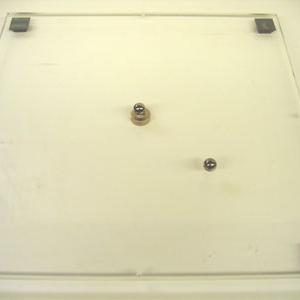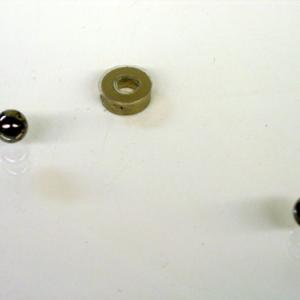College of Liberal Arts & Sciences
1L20.66/7D30.90 - Orbits on the Overhead/Mass Spectrometer Model
See also 1L20.66 in Mechanics and 7D30.90 in Modern Physics.
Place the Plexiglas plate with attached ring magnet on the overhead projector. Roll one of the ball bearings at a grazing angle across the ring magnet. Watch the ball bearing either be deflected to a different direction, or orbit the magnet.
- Michel Gagnon, "A Mass Spectrometer Simulator in Your Computer", TPT, Vol. 50, # 9, Dec. 2012, p. 553.
- Matthew Lowry, "Teaching Universal Gravitation with Vector Games", TPT, Vol. 46, # 9, December 2008, p. 519.
- S - 190: "Atoms, Molecules and Solids", DICK and RAE Physics Demo Notebook.
- David Kutliroff, "A Mass Spectrograph Analog", 101 Classroom Demonstrations and Experiments for Teaching Physics, p. 219.
- Borislaw Bilash II, David Maiullo, "Model of Mass Spectrometer: A Demo A Day: A Year of Physics Demonstrations, p. 293.
Disclaimer: These demonstrations are provided only for illustrative use by persons affiliated with The University of Iowa and only under the direction of a trained instructor or physicist. The University of Iowa is not responsible for demonstrations performed by those using their own equipment or who choose to use this reference material for their own purpose. The demonstrations included here are within the public domain and can be found in materials contained in libraries, bookstores, and through electronic sources. Performing all or any portion of any of these demonstrations, with or without revisions not depicted here entails inherent risks. These risks include, without limitation, bodily injury (and possibly death), including risks to health that may be temporary or permanent and that may exacerbate a pre-existing medical condition; and property loss or damage. Anyone performing any part of these demonstrations, even with revisions, knowingly and voluntarily assumes all risks associated with them.

